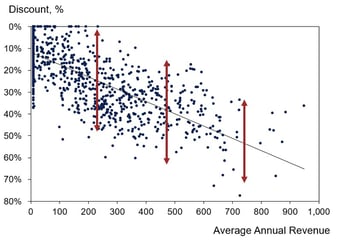At Holden Advisors, we believe a value-based approach is the best way to set a fair price for your products and services. But data-driven pricing, when done right, will lift your profit margins in the short term. Here’s the story of how hunting down hidden data turned profits around for one company.
I am a firm believer in value-based pricing. But more often than not, companies don’t commit the time nor the resources to uncover and quantify the value they create for their customers. Instead, they depend on cost-plus pricing, market pricing, or even “gut-feeling” pricing because that is what they have done historically.
In lieu of value-based pricing, using a data-driven approach is often the next best option. In fact, data analysis is a critical step in price setting or refining prices.
Let me tell you a story about harnessing the power of analytics. Fifteen years ago, I was in charge of worldwide pricing for a data storage company that mainly sold hard drives. It was my responsibility to set the channel price in the Americas, EMEA, and APAC. Before I was assigned the role, the only piece of pricing data collected was the competitive price. Interestingly, this data was supplied by the sales team, who received the data from the distributors. I had a strong suspicion this data was compromised as the distributors had the motive to reduce our pricing to them in order to make more profit.
In order to get a more balanced picture of pricing, I immediately searched for additional data sources. I found an IT person with incredible knowledge of the data collected in the accounting systems. With his help, we pulled together reports that painted a picture of demand, supply, and distributor operations.

Within a month, we had weekly reports that examined:
- Special pricing authority requests by both region and product. This told us:
- How often and at what volume special pricing was requested. From this, we could see whether there had been pricing pressure across a region or just for a specific opportunity.
- Which distributor originated the special pricing request and if there was consistency across the region.
- Distributor inventory reports. We had access to the distributors’ inventory levels, so we started pulling reports based on inventory levels like:
- Weeks on Hand reports. These helped us see if distributors were asking for pricing discounts when they had less than two weeks of supply.
- Inventory turnover reports. This provided a view of end-customer demand. From these, we learned distributors were asking for reduced prices even though the product only sat on their shelves for a day or two.
- Order demand reports. It turns out, distributors placed regular product orders going out six months because they knew their customers had large builds. This proved our distributors had no reason to ask for discounted pricing as those orders had confirmed pricing.
Within a few months, we generated a robust reporting system across all product lines and all three regions. Based on the data, we were able to make calculated decisions on whether to increase or decrease our list prices. As you can imagine, we INCREASED prices. In fact, we increased prices at a pace the industry had never experienced with little to no impact on order volumes, driving this price improvement straight to the bottom line.
The Sales team pushed back on our new process as they were getting an earful from the distributors, who saw some of their profit become our profit. Explaining our new data-driven methodology to the Sales teams in every region was a big task, though it was worth the effort as it took the emotion out of pricing decisions.
I still think value-based pricing is the best pricing method. But if you do not have the time or resources, data-driven pricing can impact decisions immediately. And with your successes, the increased profits will fund the resources to tackle value-based pricing initiatives.
My Advice: Find yourself a great data partner who understands all the information that lurks in the accounting and operational systems. You will be amazed at the number of reports you can generate and the impact you can have to drive higher margins!

